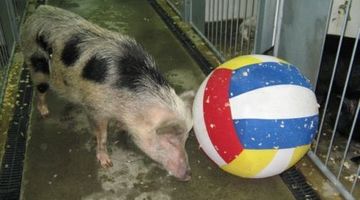Pathogens are disease-causing organisms, such as viruses and bacteria. LCT pigs are already free of most common pig diseases, and to keep them that way, they are kept in a specially designed DPF facility. This is important because LCT uses the pigs’ cells to treat humans with diseases like type 1 diabetes.
The DPF facility has a physical barrier, and everything that crosses the barrier must be sterile, including the pigs’ food, bedding, water and air. Even the staff, their clothes and equipment have to be clean before crossing the barrier.
Questions to consider
- Why is it important for LCT to rear their pigs in a DPF facility?
- What does sterile mean?
- What steps are used to ensure items inside the DPF facility are sterile?
Transcript
Isobel Cooper (Living Cell Technologies)
Designated pathogen-free means that we know the diseases that the pigs are free from, and this is because of our on-going testing that we do on them, on their blood samples. We make sure that the facility has a sterile barrier in that nothing is allowed into the facility unless it is absolutely clean, and this prevents anything – any pathogens – going in and infecting the pigs.
The facility itself was designed to be pig friendly, pig safe, keep them free from pathogens and also keep them breeding all year as well. So we designed it using tilt-slab concrete, which is very strong, and it stands up to pigs leaning on it and pushing against it. The lighting is controlled so they have the same level lighting all the time, and it comes on in the morning and then goes off at night, so they have a dark period exactly the same as they would as if they were outside.
We have a separate room where the sows go to have their babies so that they’re separate from the rest of the pigs. And this is a much quieter room, and it also has a different level of lighting, so we can keep it on quite a low level, much as you would for a human mother and baby, and we do have underfloor heating as well in the maternity suite, just at the back of the pen, so that helps keep the babies warm.
In our Invercargill facility, we have a steam autoclave so the feed and bedding goes through there and gets autoclaved much the same as instruments do in a hospital. We also have a dunk tank filled with disinfectant, so if there are things that can’t be sterilised in the autoclave, such as basketballs because they’d melt, we would then put them into the dunk tank and soak them for many hours to make sure they’re absolutely clean.
Well, the people also need to be very clean, so all of our staff, every time they go in through the barrier will strip off and take off all their jewellery and have a shower. The shower’s in between the two changing rooms, so there’s an outside changing room where they remove all their clothes, they then shower and then step out into an inside changing room, which is inside the barrier, and that’s where they put on their facility clothes and their hats and masks, gloves and boots.
Acknowledgement:
PRN Films


